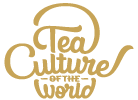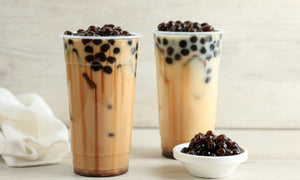What is Boba Tea?
In essence, boba tea encompasses a beverage infused with tapioca or fruit-flavored orbs.
Yet, this merely skims the surface. When one mentions ‘Boba tea,’ they allude to a conventionally chilled libation comprising a tea foundation, a milk or fruit essence, and ingestible spheres (the ‘boba’ within boba tea) encased within a vessel.
Boba tea boasts a plethora of epithets, often bewildering individuals. You may have encountered one or more of these terms, but discern that they are all synonymous: bubble tea, pearl tea, bubble milk tea, boba, boba fruit tea, or tapioca tea.
Over the past several years, Boba Tea has witnessed a surge in popularity. This phenomenon is primarily attributed to the novel and distinctive gustatory experience of relishing delectable ingestible pearls ensconced within a libation!
Tapioca Boba
Traditional milk boba tea typically incorporates tapioca balls, composed of starch and commonly dubbed ‘pearls.’
This libation generally comprises a blend of milk, water, tea, and sugar, yet offers myriad variations. Boba tea is obtainable in both warm and chilled renditions. It is typically presented in a broad-mouthed plastic receptacle and securely sealed with a transparent wrapping. (Refer to image above for elucidation)
Conventional boba pearls reside at the base of the vessel and exhibit a highly chewy texture.
Their consistency akin to a fusion of chewing gum and jell-o (fear not, devoid of gelatin), renders them a delectable treat at any hour. Most tapioca pearls exhibit a black hue, although white and transparent variants exist.
Popping Boba
Fruit-infused boba may be coupled with a myriad of toppings, but frequently features popping boba.
Popping boba constitutes ingestible, frequently fruit-filled orbs encased in a gel-like membrane. Hence the moniker, popping boba effuses with flavor upon compression. Popping boba typically comprises seaweed extract, calcium compounds, fruit nectar, water, and a sweetening agent.

Jelly Topping
The alternate preferred toppings are jellies. Jellies, reminiscent of chewy, jell-o-like, rectangular fruit-flavored morsels, are not actually formulated with gelatin. These toppings are derived from either Konjar (a vegetable by-product) or coconut flesh. Beyond their delightful flavor, jellies allure due to their lack of cholesterol and high fiber content.
Popping Boba Varieties
Supplementary boba tea toppings (Tapioca, Jellies)
Who Pioneered Boba Tea?
In essence, two distinct teahouse employees in Taiwan during the 1980s.
The First Genesis Tale
Two primary narratives elucidate the inception of boba tea. In one rendition, bubble tea traces its origins to the 1980s in Taichung, Taiwan, where Ms. Lin Hsi Hui extracted tapioca balls from her Taiwanese dessert and incorporated them into her chilled tea.
Chun Shui Tang - The Originator of Boba Tea Sales
The Second Genesis Tale
The other narrative contends that Tu Tsong-he, a teahouse proprietor in Tainan, Taiwan, was inspired to incorporate white tapioca balls into his tea upon encountering them in the marketplace.
The Proliferation of Boba Tea
Following its inception, Taiwan witnessed an exponential proliferation of boba tea establishments. The bubble industry burgeoned, featuring a diverse array of tea variants and supplementary accouterments such as pudding, popping boba, and jelly.
What Does It look Like?
Bubble tea, also known as boba tea, boasts a distinctive appearance that sets it apart from other beverages. Typically served in a transparent plastic cup, bubble tea features a base liquid, which can be either tea or a fruit-flavored drink, combined with milk or fruit pulp. The most striking aspect of bubble tea is the inclusion of edible pearls, often made from tapioca starch, which are visible at the bottom of the cup. These pearls are typically round and have a chewy texture, resembling small bubbles, hence the name "bubble tea." Depending on the type of bubble tea, additional toppings such as popping boba or jelly may also be added, further enhancing its visual appeal and taste. Overall, bubble tea presents a colorful and enticing appearance, making it a popular choice among beverage enthusiasts and social media users alike.
Why is Boba Tea Popular?
-
Unique Palate and Consumable Experience
Primarily, the imbibing encounter of bubble tea is unparalleled. One punctures a broad-mouthed straw through a protective sheath atop the receptacle.
-
Extensive Array of Flavors and Toppings
Boba tea is served with either a milk or fruit base, with some flavors being exceptionally distinct and unprecedented.
-
Aesthetic Apt for Social Media Sharing
The aesthetic allure of boba tea is unparalleled. This aspect, coupled with the myriad varieties available, impels many patrons to share their customized boba tea selections on social media platforms.
Is Boba Tea Unhealthy?
Concerns about the healthiness of boba tea are valid and have been raised by many individuals. While traditional bubble tea may seem like a harmless beverage choice, it's important to consider its nutritional content.
Bubble tea, particularly the milk-based varieties, tends to be high in sugar, calories, and fat. In fact, some studies have found that the sugar content in bubble tea can rival that of soda, making it a less-than-ideal choice for those watching their sugar intake.
Additionally, many fruit-flavored boba teas contain syrups that are loaded with artificial sweeteners and other additives to enhance flavor, further contributing to their calorie and sugar content.
Moreover, tapioca pearls, the hallmark ingredient of bubble tea, are starch-based and therefore calorie-dense. Consuming large quantities of tapioca pearls regularly can contribute to excessive calorie consumption and potentially lead to weight gain if not balanced with a healthy diet and regular exercise.
While bubble tea can be enjoyed in moderation as an occasional treat, it's essential to be mindful of its nutritional content and opt for healthier alternatives whenever possible. Making homemade versions with lower sugar and healthier ingredients or choosing unsweetened varieties from reputable sources can help mitigate some of the health concerns associated with bubble tea consumption.
Teas that can be used to make boba tea:
-
Black Tea: Black tea is the most commonly used base for boba tea. It has a bold flavor and pairs well with milk and sweeteners, making it perfect for classic milk tea boba.
-
Green Tea: Green tea offers a lighter and more refreshing option for boba tea. It has a slightly grassy and vegetal flavor that complements fruit-flavored boba teas.
-
Jasmine Tea: Jasmine tea has a delicate floral aroma and a subtly sweet flavor. It adds a unique fragrance to boba tea and pairs well with fruity and floral flavors.
-
Oolong Tea: Oolong tea has a rich and complex flavor profile with notes of floral, fruity, and earthy undertones. It adds depth and complexity to boba tea and is often used in milk teas.
-
Matcha: Matcha is a finely ground green tea powder made from shade-grown tea leaves. It has a vibrant green color and a rich, umami flavor. Matcha boba tea is popular for its bold flavor and antioxidant benefits.
-
Fruit Teas: Fruit teas are made from dried fruits, flowers, and herbs, and they come in a variety of flavors such as peach, mango, strawberry, and passion fruit. They offer a refreshing and naturally sweet option for boba tea without the need for additional sweeteners.
Boba Tea Recipe:
- Classic Milk Tea Boba: Ingredients:
- 1/2 cup tapioca pearls (boba)
- 2 cups water
- 2 tablespoons brown sugar
- 2 cups brewed black tea
- 1/2 cup milk of your choice (such as dairy, almond, or oat milk)
- Ice cubes (optional)
Instructions:
-
Boil 2 cups of water in a medium-sized pot. Add the tapioca pearls and let them cook for about 15-20 minutes, or until they are soft and chewy. Stir occasionally to prevent sticking.
-
While the pearls are cooking, brew 2 cups of black tea according to your preference. Allow the tea to cool to room temperature.
-
Once the tapioca pearls are cooked, drain them and rinse them under cold water to stop the cooking process. Transfer them to a bowl and add the brown sugar, stirring until dissolved. Let them soak in the sugar syrup for about 30 minutes.
-
To assemble the boba tea, divide the cooked tapioca pearls between two glasses. Add ice cubes if desired. Pour 1 cup of brewed black tea into each glass, followed by 1/4 cup of milk. Stir well to combine.
-
Insert a wide straw into each glass and enjoy your homemade classic milk tea boba!
2. Fruit Flavored Boba Tea: Ingredients:
- 1/2 cup tapioca pearls (boba)
- 2 cups water
- 2 tablespoons honey or sugar
- 2 cups brewed fruit-flavored tea (such as peach, mango, or strawberry)
- Assorted fruit slices for garnish
- Ice cubes (optional)
Instructions:
- Cook the tapioca pearls according to the instructions in the previous recipe.
- While the pearls are cooking, brew 2 cups of your preferred fruit-flavored tea. Allow it to cool to room temperature.
- Once the tapioca pearls are cooked, drain and rinse them under cold water. Transfer them to a bowl and add honey or sugar, stirring until dissolved. Let them soak in the sweetened syrup for about 30 minutes.
- To assemble the fruit-flavored boba tea, divide the cooked tapioca pearls between two glasses. Add ice cubes if desired. Pour 1 cup of brewed fruit tea into each glass.
- Garnish the drinks with assorted fruit slices, such as peach, mango, or strawberry.
- Insert a wide straw into each glass, stir gently, and enjoy your refreshing fruit-flavored boba tea!
These recipes allow you to customize your boba tea according to your taste preferences, and they're perfect for enjoying at home with friends and family.

